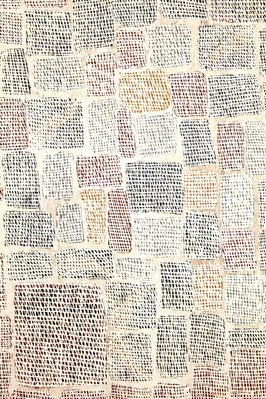Title
Djapu Miny'tji
2020
Artist
-
Details
- Place where the work was made
-
Yirrkala
→
North-east Arnhem Land
→
Northern Territory
→
Australia
- Date
- 2020
- Media category
- Bark painting
- Materials used
- natural pigment and sand on bark
- Dimensions
- 159.0 x 83.0 cm
- Credit
- Mollie Gowing Acquisition Fund for Contemporary Aboriginal Art 2020
- Location
- South Building, ground level, 20th-century galleries
- Accession number
- 153.2020
- Copyright
- © Marrnyula Mununggurr. Buku-Larrnggay Mulka Centre, Yirrkala
- Artist information
-
Marrnyula Munuŋgurr
Works in the collection
- Share
-
-
About
The art centre documentation for the work states:
“Marrnyula has created the cross-hatching grid pattern which is the sacred design for the freshwaters of the Djapu clan at their homeland Waṉḏawuy, now an outstation about 150 kilometres south of Yirrkala and inland from Blue Mud Bay. The grid refers to the landscape of Waṉḏawuy - a network of billabongs surrounded by ridges and high banks. Its structure also having reference at one level to woven fish traps. Ancestral Hunters set a trap here to snare the Shark but to no avail.Areas of the river are staked by the Yolŋu and branches interwoven through them. Then the water is polluted by a particular pulped bark that anaesthetises the Gaṉŋal (catfish) that hobble to the surface. With nets constructed similarly to the beak of Galumay (the pelican), the Yolŋu wade through the waters scooping up the fish. It has been fished since Ancestral times. Gaṉŋal the catfish, totem for the Djapu is ceremonially sung as is Galumay the pelican. Both these species frequent the waters of Waṉḏawuy.
Mäna, the Ancestral shark in its epic travels comes through this way. These ancestors try to trap Mäna in the freshwater by means of these traps in the waterways. They fail. The powers and physical strength of the shark overcome the efforts of mere mortals. Mäna’s ire and thrashing tail smash the trap and muddy the water. They witness however the strength of Mäna and sing his actions, the thrashing of his tail, the muddying or contamination of the water.At ceremony appropriate participants for mortuary rites enter the shelter (woven together like the unsuccessful trap) where the deceased has been lying in state. Sacred spears tipped with stingray barbs, manifestations of Mäna’s teeth, stand up alongside the shelter. At the prescribed time at the conclusion of ceremony the dancers crash through the deceased’s shelter imitating the actions of Mäna at the trap. This action has reference to the release of the deceased’s soul, back to the sacred waters of Waṉḏawuy to be reunited with its ancestors awaiting rebirth.”
-
Places
Where the work was made
Yirrkala
-
Exhibition history
Shown in 1 exhibition
20th-Century galleries, ground level (rehang), Art Gallery of New South Wales, Sydney, 20 Aug 2022–2023




